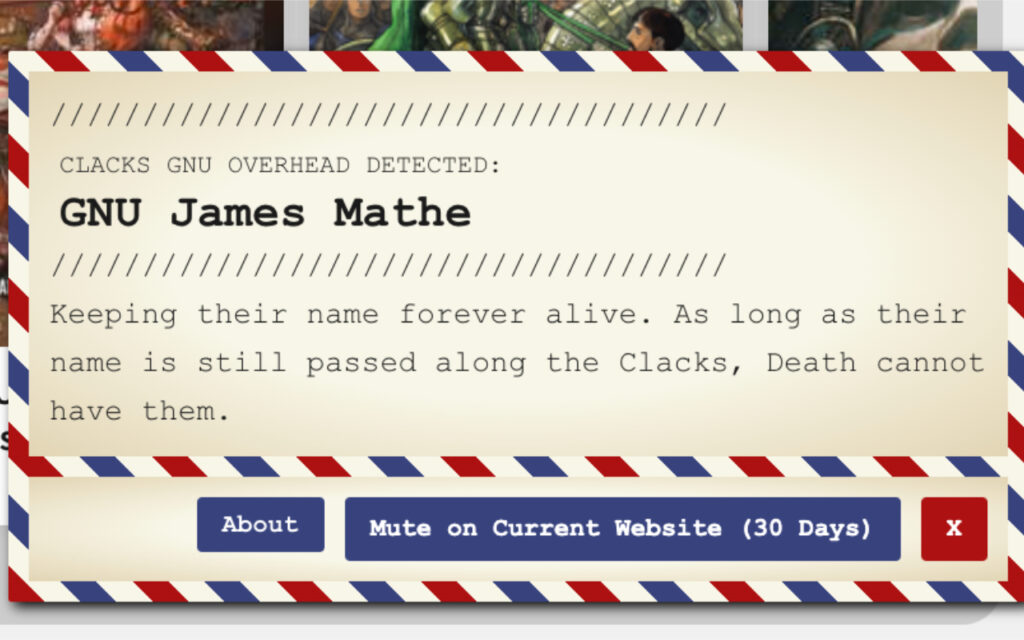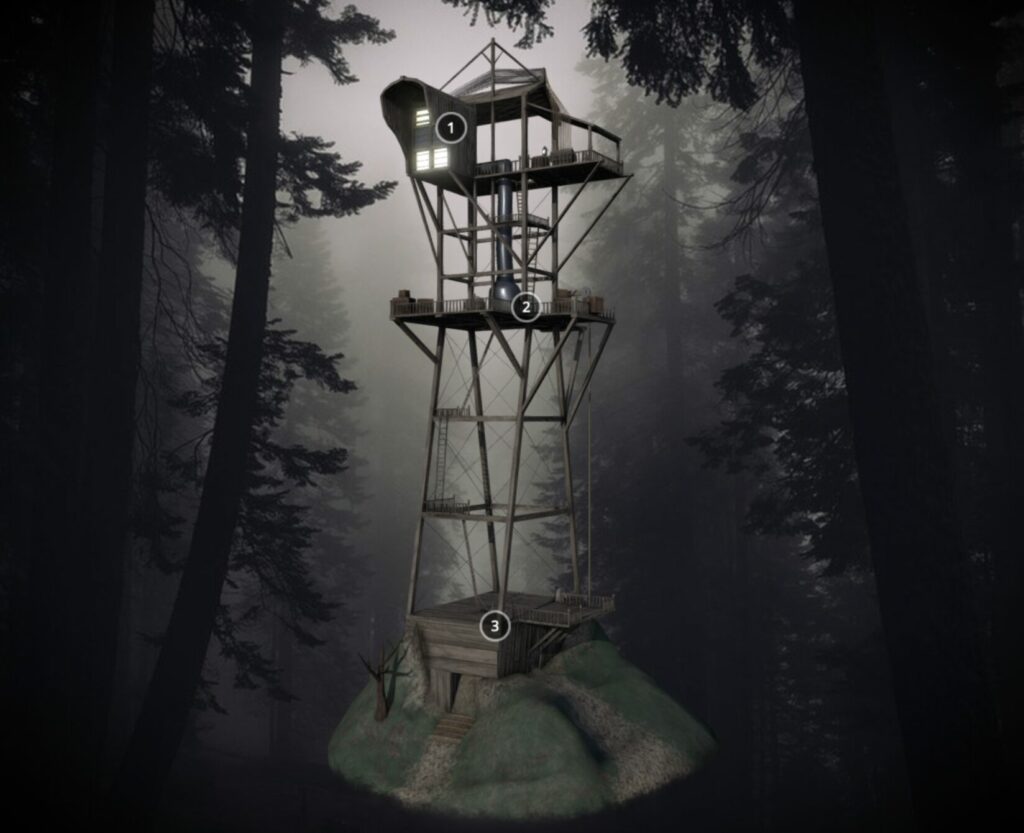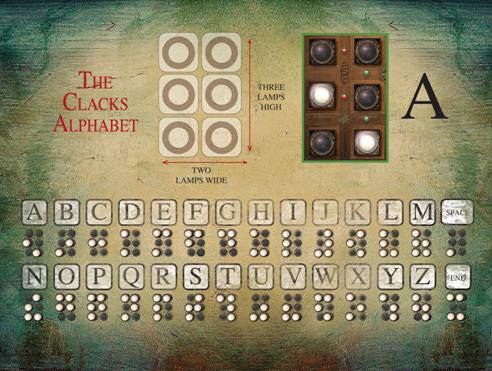Have you ever wondered if a website could whisper secrets? Turns out they can, and some of them are using this ability to honor and memorialize the dead.
Terry Pratchett’s Discworld series is one of my all-time favorites. This series consistently delivers humor, insight, and a satirical mirror to our world. But his writings on Discworld have gone beyond the series, inspiring many tributes, games, and fan creations. This includes a unique way of memorializing the dead by way of the very fabric of the internet.
Across the internet, select websites are silently transmitting the names of deceased they wish to honor in their headers, a system inspired by an invention in Pratchett’s own Discworld: the clacks.
Let’s take a look at what the clacks are, some basic technical information on how the x-clacks-overhead header is used, and take a look at a Chrome extension I created to make it easier to see these memorials around the internet.
If you just can’t wait, you can check out my free X-Clacks-Overhead Detector extension for Chrome browsers over at the Chrome Web Store. This browser extension will give a little popup whenever you visit a website using the x-clacks-overhead header, letting you know who is being memorialized.

Get the free X-Clacks-Overhead Detector extension on the Chrome Web Store
The Clacks: Discworld’s Internet
Introduced in Pratchett’s novel “The Fifth Elephant” and more fully explored in “Going Postal,” the clacks is Discworld’s version of telecommunication. A blend of semaphore tower and telegraph, the clacks brought rapid information exchange to a world otherwise limited by the speed of horse and carriage.

Each tower in the long chain is a simple three-story structure topped with a complex mechanism of shutters and lamps. Skilled operators use a system of coded signals to relay messages up and down the line. Think “steampunk networking systems” and you’ll pretty much have it right.
But, of course, in the hands of Terry Pratchett the clacks is more than just an interesting communication system. In his story it becomes a metaphor for technological progress and is used to explore themes of innovation, unchecked corporate greed, and the human cost of rapid advancement.
As we jump into talking about the x-clacks-overhead webpage header itself, keep the image of these clacks towers in mind. The story around them is what directly inspired these hidden messages in the websites we use every day.
The GNU Code

In the world of the clacks, some message transmitted carry a special significance. Some messages will carry a directive encoded in the characters G, N, and U that form the backbone of a really touching tribute and a consideration of memory and loss typical of Pratchett’s style.
Let’s decode the GNU:
- G: “send this message on”
- N: “do not log this message”
- U: “turn this message around at the end of the line and send it back again”
While this might seem like a bit of quirky technical jargon, messages prefixed with GNU are destined to echo endlessly through the clacks network. They bounce back and forth, becoming a perpetual whisper in the system’s background noise.
In Pratchett’s world, John Dearheart (son of the clacks’ inventor Robert) dies in a clacks tower accident and his fatehr finds a unique way to keep his memory alive in the clacks. By sending out the message “GNU John Dearheart,” he ensures his son’s name will forever live in the network.
It’s a beautiful message that’s always resonated with me: as long as his name travels the clacks, he’s never truly gone.
GNU Inspiring Tech Savvy Fans
This idea clearly resonates with other Pratchett fans as well, particularly those in the tech world, and it’s not hard to see why. In our current digital age, where data might theoretically exist forever, the concept of the GNU feels especially relevant.
This fictional act of remembrance inspired real-world developers to find a way to quietly bring the GNU into our own internet by using a hidden but omnipresent part of web architecture: HTTP headers.
This is where Pratchett’s fictional memorial jumps from Discwolrd into the framework of our own online world.
Website Response Headers: The Whispers in the Network
Every time you visit a website, a secret conversation happens behind the scenes, handled by your browser. Your browser asks for some specific information and the website’s server responds. This back-and-forth includes bits of data called “headers,” which you can think of as invisible Post-it notes attached to the website you’re viewing.
What are HTTP headers?
These webpage headers come in two varieties:
- Request Headers: Sent by your browser, defines the information that is being asked for
- Response Headers: Sent by the website’s server, providing details about the data that’s being returned
Usually these headers just contain technical information that end users rarely see, but sometimes they hide something special: the x-clacks-overhead header.
The x-clacks-overhead header
Remember the GNU code from the clacks? Some clever and creative developers came up with the idea to bring this concept to life using a custom response header called x-clacks-overhead.
When a website includes this header, it’s silently transmitting names with every page load, just like the clacks system in Discworld. From my exploration of its use, it’s primarily used to memorialize Terry Pratchett himself with the header value “GNU Terry Pratchett,” but is used by different websites to memorialize a variety of people that had an impact on the developers.
While they aren’t necessarily obvious, these headers are relatively easy to find if you know what to look for. There are two routes you might take to dig up these messages.
Use your browser’s inspector tools to view x-clacks-overhead headers
- Right-click on any webpage (you can use graycastlepress.com as an example!) and select “Inspect” or “Inspect Element”
- Go to the “Network” tab
- Reload the page and click on the first item (usually the page URL)
- Look for “Response Headers” and find
x-clacks-overheadin the list if it exists for the current website

My free X-Clacks-Overheard Detector Chrome extension
I’ve created a free extension that automatically detects and displays these hidden messages. It’s a simple way to discover which websites are participating in this unique form of remembrance. You can find this extension on the Chrome Web Store

By using these methods you can uncover a hidden layer of the internet that pays tribute to beloved figures and keeps their memory alive.
Leaving a Digital Legacy in the Internet’s Background Noise
I’m always so thrilled when I see people take inspiration from such niche, specific sources like this. To have read Going Postal by Terry Pratchett and thought “wouldn’t it be cool if…” is something I admire so much.
The x-clacks-overhead header is more than just a clever nod to Terry Pratchett’s Discworld. It’s a beautiful intersection of literature and tech where fantasy inspires real-world innovation. It shows us that being honored and rememberd in the digital age can take on new forms, and how fandom, when channeled creatively, can leave a mark on our world.
As Pratchett wrote, “A man is not dead while his name is still spoken.” This hidden HTTP header continues to speak the names of the dead in a whisper across the internet.
The next time you browse the web, remember that an invisible memorial just behind what you can see may be keeping alive the spirits of those we wish to remember. In this small way, the internet has become a global tribute to the power of words and memory.
